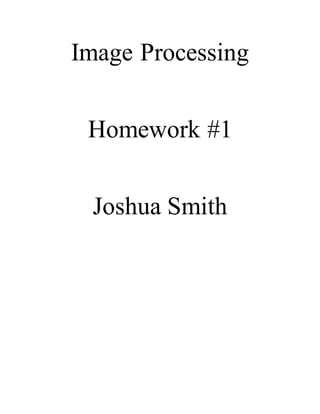
Image Processing Homework 1
- 1. Image Processing Homework #1 Joshua Smith
- 2. Smith 2 Objectives Using the histogram techniques discussed in class, search the image provided to recover the hidden message. Utilize histogram equalization to adjust the intensity values for the given image to create a new image that shows the hidden message. Equipment and Materials Time Matlab Files from Dr. Gleb
- 3. Smith 3 Methods A message is hidden in this image. The histogram for this image is shown below. This graph shows the color intensities verses the bit counts for the original image. Using this image and histogram I created multiple m-files in Matlab which implemented the formula 𝑠 𝑘 = 𝑇( 𝑟 𝑘) = (𝐿 − 1) 𝑀𝑁 ∑ 𝑛𝑗 𝑤ℎ𝑒𝑟𝑒 𝑘 = 0,1,2, … , 𝐿 − 1 𝑘 𝑗=0
- 4. Smith 4 to create a map for transforming the image. The transformed image would allow us to read the hidden message. Results For this project I wrote multiple m-files to transform the given image. My first attempt was a global histogram transformation. clear all closeall A = imread('image01.bmp') % Load the image into the matrix A [Counts,X]=imhist(A); % Gathers data about the intensity values in the image for k=1:1:256 % Loop that builds thehistogramvalues for the new image if k == 1 s(k) = ((255)/(417*400))*Counts(k,1); p = Counts(k,1); elseif k>1 s(k) = ((255)/(417*400))*(Counts(k,1)+p); p = p + Counts(k,1); end end s=round(s)'; % Converts the new intensities to intager values for L = 1:255 % Writes a new image based on the old image and the new histogram % values for x = 1:417 for y = 1:400 if A(x,y) == L-1 B(x,y) = s(L); end end end end figure(1), imagesc(B) colorbar colormap('gray')
- 5. Smith 5 This code transforms the entire image and produced this linear transformation and converted image. The word “Congratulation!” is written across the top above the motor, but it is not very visible. To improve the visibility I pulled the part of the image containing the word, and then transformed just that section of the picture. clear all closeall
- 6. Smith 6 A = imread('image01.bmp'); % Load the image into the matrix A C = A(50:100,100:350); % Load the section of the image with the word into the matrix C [Counts1,X1]=imhist(C); % Gathers data about the intensity values in the image for k=1:1:256 % Loop that builds thehistogramvalues for the new if k == 1 s1(k) = ((255)/(417*400))*Counts1(k,1); p1 = Counts1(k,1); elseif k>1 s1(k) = ((255)/(417*400))*(Counts1(k,1)+p1); p1 = p1 + Counts1(k,1); end end s1=round(s1)'; % Converts the new intensities to intager values for L = 1:255 % Writes a new image based on the old image and the new histogram % values for x = 1:51 for y = 1:251 if C(x,y) == L-1 B(x,y) = s1(L); end end end end figure(1), imagesc(B) colorbar colormap('gray') This code gave me the following image and transformation curve.
- 7. Smith 7 This section of the image had only a few different color intensities in comparison to the main image. The first image is with very close borders which reduced the number of intensities included, and the second image is with further expanded borders thus including more bit intensities and producing a better averaging transformation. Performing the transformation and converting the image made the message easier to read. This local transformation produced much better results. To try and further improve the readability of the message I cut the extracted image of the word in half and applied histogram equalization to each image separately. I then put the image back together to see the results. clear all closeall A = imread('image01.bmp'); C = A(50:100,100:225); D = A(50:100, 226:350); [Counts1,X1]=imhist(C); [Counts2,X2]=imhist(D);
- 8. Smith 8 for k=1:1:256 if k == 1 s1(k) = ((255)/(417*400))*Counts1(k,1); p1 = Counts1(k,1); elseif k>1 s1(k) = ((255)/(417*400))*(Counts1(k,1)+p1); p1 = p1 + Counts1(k,1); end end s1=round(s1)'; for w=1:1:256 if w == 1 s2(w) = ((255)/(417*400))*Counts2(w,1); p2 = Counts2(w,1); elseif w>1 s2(w) = ((255)/(417*400))*(Counts2(w,1)+p2); p2 = p2 + Counts2(w,1); end end s2=round(s2)'; for L = 1:255 for x = 1:51 for y = 1:126 if C(x,y) == L-1 B(x,y) = s1(L); end end end end for H = 1:255 for m = 1:51 for n = 1:125 if D(m,n) == H-1 E(m,n) = s2(H); end end end end figure(1), imagesc([B,E]) colorbar colormap('gray')
- 9. Smith 9 The image produced is shown below. This image was the best image I could produce using histogram equalization. It is fairly clear and readable. I did try to break the section of the image into four small pictures to use histogram equalization on each one, but the results were terrible. This image is almost as bad as the original image. The hidden word is almost indistinguishable from the background. I learned from this that more is not always better. I think that there was not enough of a range of differences in the histograms to produce a useful equalization function. The histogram for the far right image is shown below.
- 10. Smith 10 This histogram shows that the concentration of color is very dark and the equalization process would not change this enough to help us view the image. The transformation plot for the far right image is shown below. This transformation curve only sets a small range of bit intensities. I also tried adjusting the image using both the power and logarithmic transformations. Each of these methods caused a portion of the hidden word to become visible, but not the full word. My image is not as clear as I would like and I think that further testing and familiarization with the method of histogram equalization would improve the results. I also think that applying different types of image transformations along with the histogram equalization would produce a better image.